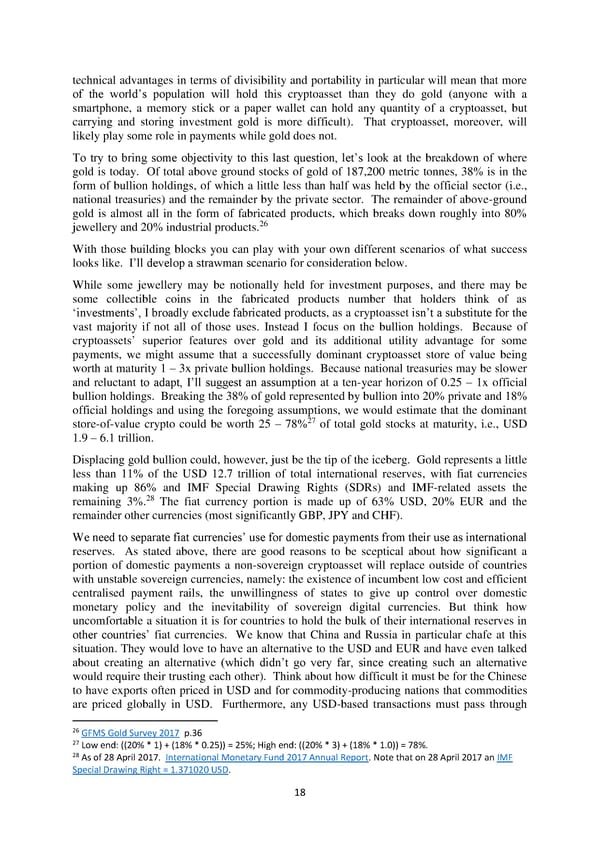technical advantages in terms of divisibility and portability in particular will mean that more of the world’s population will hold this cryptoasset than they do gold (anyone with a smartphone, a memory stick or a paper wallet can hold any quantity of a cryptoasset, but carrying and storing investment gold is more difficult). That cryptoasset, moreover, will likely play some role in payments while gold does not. To try to bring some objectivity to this last question, let’s look at the breakdown of where gold is today. Of total above ground stocks of gold of 187,200 metric tonnes, 38% is in the form of bullion holdings, of which a little less than half was held by the official sector (i.e., national treasuries) and the remainder by the private sector. The remainder of above-ground gold is almost all in the form of fabricated products, which breaks down roughly into 80% jewellery and 20% industrial products.26 With those building blocks you can play with your own different scenarios of what success looks like. I’ll develop a strawman scenario for consideration below. While some jewellery may be notionally held for investment purposes, and there may be some collectible coins in the fabricated products number that holders think of as ‘investments’, I broadly exclude fabricated products, as a cryptoasset isn’t a substitute for the vast majority if not all of those uses. Instead I focus on the bullion holdings. Because of cryptoassets’ superior features over gold and its additional utility advantage for some payments, we might assume that a successfully dominant cryptoasset store of value being worth at maturity 1 – 3x private bullion holdings. Because national treasuries may be slower and reluctant to adapt, I’ll suggest an assumption at a ten-year horizon of 0.25 – 1x official bullion holdings. Breaking the 38% of gold represented by bullion into 20% private and 18% official holdings and using the foregoing assumptions, we would estimate that the dominant 27 store-of-value crypto could be worth 25 – 78% of total gold stocks at maturity, i.e., USD 1.9 – 6.1 trillion. Displacing gold bullion could, however, just be the tip of the iceberg. Gold represents a little less than 11% of the USD 12.7 trillion of total international reserves, with fiat currencies making up 86% and IMF Special Drawing Rights (SDRs) and IMF-related assets the remaining 3%.28 The fiat currency portion is made up of 63% USD, 20% EUR and the remainder other currencies (most significantly GBP, JPY and CHF). We need to separate fiat currencies’ use for domestic payments from their use as international reserves. As stated above, there are good reasons to be sceptical about how significant a portion of domestic payments a non-sovereign cryptoasset will replace outside of countries with unstable sovereign currencies, namely: the existence of incumbent low cost and efficient centralised payment rails, the unwillingness of states to give up control over domestic monetary policy and the inevitability of sovereign digital currencies. But think how uncomfortable a situation it is for countries to hold the bulk of their international reserves in other countries’ fiat currencies. We know that China and Russia in particular chafe at this situation. They would love to have an alternative to the USD and EUR and have even talked about creating an alternative (which didn’t go very far, since creating such an alternative would require their trusting each other). Think about how difficult it must be for the Chinese to have exports often priced in USD and for commodity-producing nations that commodities are priced globally in USD. Furthermore, any USD-based transactions must pass through 26 GFMS Gold Survey 2017 p.36 27 Low end: ((20% * 1) + (18% * 0.25)) = 25%; High end: ((20% * 3) + (18% * 1.0)) = 78%. 28 As of 28 April 2017. International Monetary Fund 2017 Annual Report. Note that on 28 April 2017 an IMF Special Drawing Right = 1.371020 USD. 18
 Investor’s Take on Cryptoassets by John Pfeffer Page 17 Page 19
Investor’s Take on Cryptoassets by John Pfeffer Page 17 Page 19